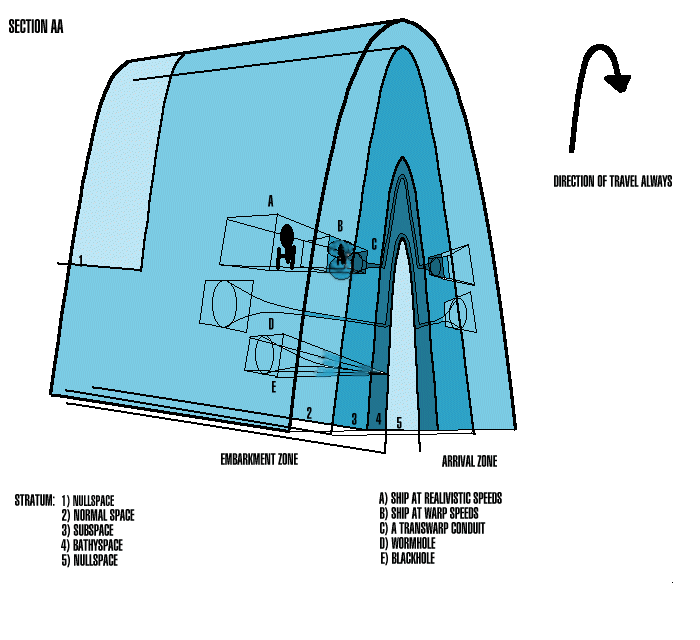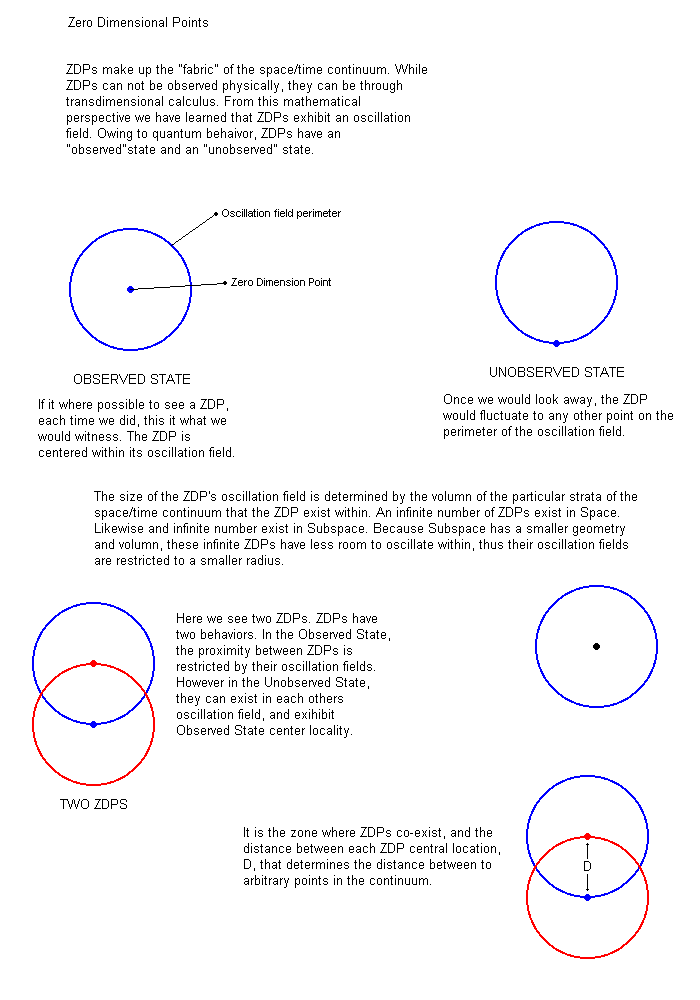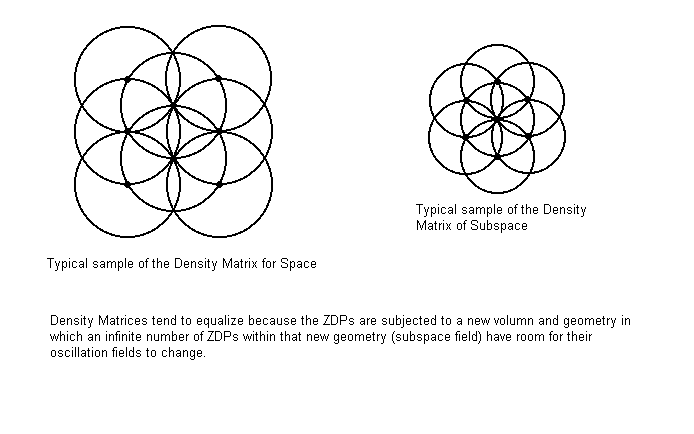
Author's Note: these theories came about by reading other theories--more scientific theories--on the 'net and wanting a better explaination that described what was happeing on the show. I wanted something in laymans' terms that was very easy to follow, or rather easier to follow and understand. There were none so I decided to write my own. Now I can't say that the below will not violate Conservation Laws or Relativity. It is not my intention to abide by such laws, for even today there are devices that violate Conservation Laws. Also how can we accurately say how differing future generations will understand and describe the universe they live it. I'm sure Newton, or Kepler would have scoffed at the idea of an expanding universe and light rays being bent by high gravitational sources. No doubt, some of you may scoff at my ideas. Because I give you absolutely no math, I don't know how well it would stand up to such scrutiny, but hey, it's only science fanatsy, right?
By Paul Cargile
(As edited by Robert "Baloo" Dunehew)
and further explained by Paul again.
What is subspace?
Subspace can best be described with the concept of density. Therefore, subspace is an intermediate infrastructure of the space/time continuum (S/TC) where its expansion density is greater than normal space (N-space) by orders of magnitude determined by the distance from the originating singularity, relative to the standard distance of N-space.
The "deeper" into subspace you go, the more dense the spacial continuum is. Following the balloon anology of the Big Bang, the surface of the balloon is normal space, and the distance between two points (as measured along the surface) is increasing at a constant rate. Over short (intra-galactic) distances, any expansion in the local continuum is immeasurable by methods presently available to Federation science. As the skin of the balloon represents N-space, the interior of the balloon represents subspace.
Subspace occupies a smaller geometry than space, and so its density is greater and the distance between two corresponding points are closer together than in space. Likewise, as one enters denser regions of subspace, the geometry becomes proportionally smaller and thus the distance. Once the density reaches infinity, all points in space/time exist as a single point. This "null point" is dubbed nullspace and is the region of subspace that corresponds to Warp Factor 10. The density of S/TC can be best explained as the net vacuum, or zero point, energy permeating the particular strata.
[Editor's note: Excellent! I fully understood the above concepts. The only suggestion I can make is to put as much as possible in "present tense". That gives the text immediacy, and ensures you don't sound like someone's boring math teacher. ;-) Once again, excellent!]
How does warp drive work?
Warp drive works on the principle that space and subspace, when forced into the same domain, have a natural tendancy to equalize their density, similar to how high and low pressure cells achieve equalibrium.
[Editor's comment: Perhaps the "density" of subspace is what keeps N-space from collapsing altogether. That way, activating a warp field or drive is analagous to a submarine filling its ballast tanks. As the field energizes, the vessel (and the pocket of space within the field) "sinks" into subspace. When the field collapses, you "lose ballast" and return to the lower density region you came from.]
{Good anology.}
A warp field of 1000 millicochranes (1 cochrane) "compresses" the space within it to a greater density than that outside the field. Subspace (the warp field) is forced into space. Density equilibrium is achieved which causes some changes in subatomic properties, negating the mass of specific quarks and, overall, reducing the mass of any object(s) within the subspace field. If the field is symetric and no longer receiving power, the field collapses as the low density of space dissipates the higher density of subspace.
[Editor's comment: ??? What's going on here? The above paragraph is so densely packed with technogobble that it has impacted my brain, creating a (temporarily) denser (than normal) condition which hinders my comprehension. I have only a vague notion what you were getting at here. I suggest you look over your warp drive section and see what you can do to "de-obfuscate". All I can gather from the above is "warp drive works". The rest is smoke and mirrors.
{Ok. What I'm attempting to do here is explain what we see on the show. We know subspace fields reduce mass, and here I am explaining (rather badly) that they do it by transforming the spin, charge, magnetic moment, or whatever of a quark to a negative value so that the quark has negative mass. All these negative quarks are still bound to the other quarks so particles maintain coherency, yet the particles are reduced in mass and so on and so forth.}
Well, anyhow, it's difficult to understand most of it. It's not clear if the ship remains in N-space, and subspace "protrudes" or if the ship "sinks" into subspace, or perhaps something else is happening. For instance, what does the reduction of mass do?]
{I think it is both protrusion and sinking. Think of space as being air, and subspace as being water, then a ship in a warp field is floating on the water. So using this analogy, the ship has a natural tendency to float up into the air and must fight this tendency to sink deeper into the water. The mass reduction is just a lucky side affect. Most of this is just explaining basic subspace fields and their effect.}
If the field is continually replenished with power and the density increased and fluctuated faster than the equalization process, the subspace bubble will not collapse. Because the densities tend to equalize, the field maintaining the density must be refreshed constantly. This is done by using several coils capable of creating subspace density fields (warp fields) and activating them peristaltically in either desired direction. To use this for propulsion, the field is produced with asymetric geometry along the Y axis. This allows some equalization to occur in some regions while denying it in others. This distorts space immediately outside the field producing inflation and collapse of space along a predetermined axis in such a manner as to cause propulsion.
[Editor's note: The above paragraph was much better. I understood what you are getting at. Does the "bubble" travel in N-space, subspace, or the entire continuum (at least at its location)?]
{The above is to be understood as a Warp 1 equivalent symetric and unsustained subspace field. I believe warp 1 would be in both strata, like the ship on floating in water. But higher warp factors do drive the vessel into subspace. . . }
The fact that space and subspace within the warp field are expanding at the same rate but in different-sized geometries, yet are co-existing in the same domain, causes the inflation and collapse of space. With the universe is expanding at c, the inflation and collapse rates are greater than c, determined by the smaller geometry and greater density of subspace. The vessel is not moving at true FTL velocities, but moving in a higher density of the continuum in which mass is reduced and distances closer together. Because the subspace bubble is riding the inflation/collapse distortion, the ship remains in a zone of space/subspace coexistance, and is exposed, through subspace, to the laws of acceleration and inertia. To counter such forces, the interior of the ship is saturated with lower density subspace fields than those existing at Planck distance from the outer hull.
[Editor's note: I got most of that, but I'm not entirely sure what you meant.]
{. . . while retaining some n-space within the field. We know there are more than one field at work and they work off on another. The outermost fields are at subspace densities, which dissipitate, only to be reenforced by a new field. Only the outer field is driving the ship into subspace, the weaking fields are losing density but not so much that they are true n-space. The space/subspace coexistanst zone is merely a zone where the densities have equalized or in the process of equalizing. I may have to draw a picture.}
What determines the boundary between space and subspace?
The normal determing factor is the expansion rate of the universe. This means that subspace doesn't expand beyond space by naturally. To do so the region of subspace would have to expand faster than c, whereupon it would lose its density [Editor's note: And perhaps become normal space?].{Right!} There are regions of subspace that do exist naturally in space, such as blackholes and cosmic strings.
Another factor is that space, having a significately lower density, is more subject to distortion. For example a specific mass in space has a specific gravity well. That same mass in subspace has a smaller gravity well. Mass and energy distorts space and thusly increases the density of the region they are located, but often not to the extreme that subspace is created.
What is bathyspace?
Bathyspace is primarily an order of subspace density magnitude where distances are virtually nonexistant. Bathyspace is not known to be able to co-exist with space for a workable propulsion system. In such, to utilize bathyspace for travel, it is speculated that the vessel must be able to project a bubble of space into the higher density levels. No Federation or Starfleet working model has yet been able to achieve this feat. This is commonly called the Transwarp Domain, because normal warp theory can not produce a field that will attain such densities.
[Editor's note: Hallelujiah! I understood that completely! Of course, this implies answers to a few of my questions above, but this part is good!]
What is nullspace?
Nullspace is a region of such high density that distances are non-existant and all points of the universe exist as one.
[Editor's note: Perhaps you might expand upon this some more. I think it's already mentioned somewhere above that nullspace has the properties in the above paragraph. You might just want to add this sentence to the paragraph that mentions nullspace and leave it at that?]
How do subspace damaging particles, molecules, and/or weapons destroy subspace?
The Omega molecule is unique in that its detonation forces subspace to inflate so that it becomes normal space. It essentially robs subspace of the vaccuum energy needed to sustain higher densities. This affects subspace down to the highest densities of bathyspace, but it is unknown whether or not it extends to nullspace.
[Editor's note: You mentioned other particles and weapons in the heading to this section. I think it either needs more examples, or a more generalized example than the one given.]
{It could use so more, but the subspace damaging weapons use the Omega molecule. There hasn't been any other episodial source that hinted at destroying subspace.}

Another note: the following explains in more detail using the comcept of zero point energy. At this time I have not combined both ideas into one document.
The space/time continuum is a domain of zero dimensional points (ZDP) that commonly oscillate at finite frequencies, creating a zero-point fluctuation field. The contiuum can then be said to be a zero-point energy density matrix. (The term "zero-point" does not describe the zero dimension but rather the fact that these points oscillate even at absolute zero.) This density matrix is uniform throughout space except in regions of high gravity sources such as black holes. The distance between these points is determined by the net potential energy of the entire density matrix. Each ZDP is seperated from another by the area of its oscillation. The smaller the oscillation field, the closer distance is observed and the greater the density matrix.
As stated, Space has a realitively uniform density matrix. The Subspace region is unique in that it not isotropic, but varies in density with the least density closer to the density of Space. In the inflationary universe model, the universe began as a point that had more energy that it should. To achieve balance, this point shed it's extra energy in the form of kenetic energy/mass, which has been "radiating" from this original singularity for trillions of years. Space is the "outer shell" of this event. Subspace is the component of the contiuum that connects Space to the original singularity. It is an intrastructure that is expanding at the same rate, but as a smaller geometry than Space. Subspace's higher density matrix means that arbitrary points in Subspace are closer together than those same points in Space. The denser Subspace becomes, the closer distances are, until distance no longer exists at the originating singularity. Continuum density is determined by oscillation, not the number of the ZDPs existing in the various strata. Strangely, the denser the contiuum becomes, the less in number the ZDPs become. This also plays a factor in realitive distance. Since all points "touch", the number of points determine the geometric size of the density matrix. Therefore Space has the lowest density, the farthest distance between two ZDPs, and the greatest size. Subspace has increasing density, closing distance, and shrinking size. The originating singularity, or Nullspace, has infinite oscillation (density can not be applied here because there is only one ZPD), zero distance, and zero size.

